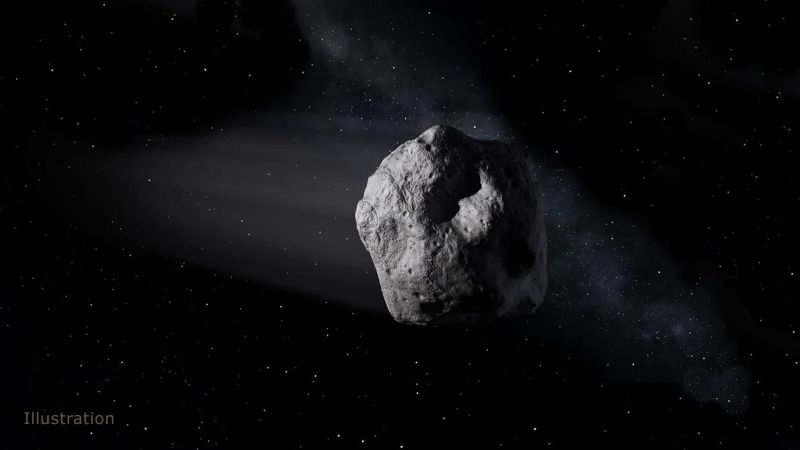The cosmos continues to unravel its mysteries, and a recent discovery concerning a near-Earth object has captivated scientists and space enthusiasts alike. A small space rock, colloquially known as 2024 PT5, which had been temporarily categorized as a “mini-moon” of Earth last year, is believed to actually be a fragment of the Moon itself. This intriguing hypothesis stems from research revealing that the celestial body likely originated from the lunar surface, having chipped off thousands of years ago due to impact events.
2024 PT5 measures approximately 33 feet (10 meters) in diameter. Despite its potentially hazardous classification in the past, researchers assure us that it poses no threat of collision with Earth, either now or in the foreseeable future. Following its close approach, 2024 PT5 has entered a more distant orbit, gradually moving away from our planet. What is particularly fascinating is the asteroid’s orbit: it mirrors Earth’s trajectory around the Sun, suggesting that it originated from our own solar neighborhood.
Initial observations of 2024 PT5 were made on August 7 using the facilities of the Asteroid Terrestrial-impact Last Alert System (ATLAS), which is based in South Africa and funded by NASA. Predictions indicated that the asteroid might take on the role of a temporary mini-moon – an intriguing idea that captured the imagination of astronomers. However, as Dr. Teddy Kareta, the lead author of a study published in the **Astrophysical Journal Letters** on January 14, explained, it maintained a unique horseshoe orbit that brought it close to Earth without ever fully entering its gravitational pull.
Dr. Kareta noted the difficulty in assigning a catchy nickname to the asteroid’s peculiar motion. He indicated that although it was nearly in orbit, the dynamics of its approach and subsequent departure don’t lend themselves well to familiar terminology. During its two-month trajectory, the asteroid was observed using both the Lowell Discovery Telescope and the NASA Infrared Telescope Facility located at Hawaii’s Mauna Kea Observatory. There, researchers noted its surface characteristics remarkably resembled lunar rock samples brought back from the Moon.
A pivotal discovery was that 2024 PT5 is abundant in silicate minerals, the type commonly found on the Moon but absent from typical asteroids. This component suggests a relatively young age, likely indicating it has not been exposed to space for longer than a few thousand years. The presence of these minerals was so substantial that it provided a “smoking gun” piece of evidence linking the asteroid to lunar origins.
Kareta’s exploration of near-Earth objects has implications for understanding the history of impacts on the Moon and their subsequent effects, including the ejection of material from its surface. The investigation sheds clarity on a nascent population of lunar asteroids, raising questions about the number of rocks that may have been flung into Earth’s vicinity through various collision events over millennia.
While studying 2024 PT5, scientists compared its movement to that of man-made debris, ensuring the object’s behavior aligned with that of a natural space rock. This distinction is vital as space debris, generally lighter and more susceptible to solar radiation pressure, responds differently to forces exerted by sunlight. This study confirmed 2024 PT5’s substantial density, setting it apart from typical space debris.
Specialists like Robert Jedicke from the University of Hawaii’s Institute for Astronomy have voiced strong support for the lunar origin hypothesis, affirming that exhaustive analyses suggest more than mere coincidence. The theory considers that objects similar to 2024 PT5 could be remnants from the Moon, a result of asteroids or comet impacts serving as catalysts for their trajectory changes.
Since its discovery, multiple studies have backed the idea that 2024 PT5 is a fragment of the Moon, indicating research in this area is gaining momentum. Furthermore, including studies like that of Carlos de la Fuente Marcos from the Complutense University of Madrid, astral scientists are converging on the understanding that the dynamics of 2024 PT5 can only be explained by its lunar roots, raising questions about other similar objects yet to be cataloged.
As scientists siphon insights from 2024 PT5, they are challenged to enhance detection strategies for yet more asteroids like it, particularly with advanced observational tools such as the Vera Rubin Observatory and the NEO Surveyor, which are expected to revolutionize our ability to identify and study these celestial objects. The excitement surrounding 2024 PT5 highlights just the beginning of an exploration into the intriguing connections between Earth’s history and its neighboring celestial bodies. Each discovery prompts the scientific community to ask further questions and reopen chapters previously closed, ensuring that the understanding of our cosmic neighborhood continues to expand.











